Business Law - Exam 2
1/310
There's no tags or description
Looks like no tags are added yet.
Name | Mastery | Learn | Test | Matching | Spaced |
|---|
No study sessions yet.
311 Terms
Agency
a fiduciary relationship which results from the manifestation of consent by one person to another that the other shall act in his behalf and subject to his control, and consent by the other so to act
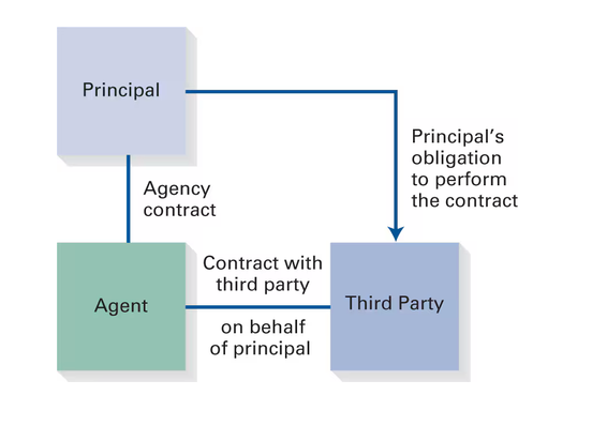
Persons Who Can Initiate an Agency Relationship
Any person who has the capacity to contract
Can only be created to accomplish a lawful purpose
Principal-Agent Relationship vs. Employer-Employee Relationship
Ex. A welder on General Motors Corporation’s automobile assembly line is employed to perform a physical task but is not given authority to enter contracts
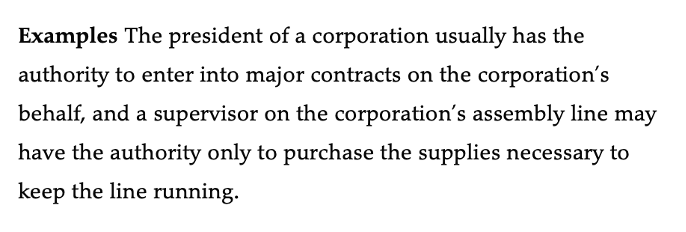
Independent Contractor
a non-employee retained to perform certain tasks on a principal’s behalf
An independent contractor operates its own business or profession
A principal can authorize a ____ to enter into contracts on its behalf
Ex. If a client authorizes an attorney to settle a case within a certain dollar amount and the attorney does so, the settlement agreement is binding.

Formation of an Agency - Express Agency
Agent has authority to contract or otherwise act on the principal’s behalf as stated in an agency agreement
Power of Attorney (general vs. special)
Ex. A person who has her house listed for sale but who is going on a trip givers her sister a special power of attorney to make decisions regarding the selling of her house while she is gone, including accepting offers to sell the house and signing documents and deeds necessary to sell the house.
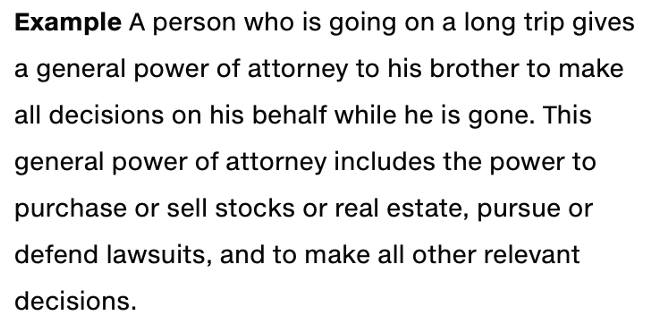
Formation of an Agency - Implied Agency
Implied from the conduct of the parties

Formation of an Agency - Agency by Ratification
Occurs when (1) a person misrepresents themselves as another’s agent, and (2) the purported principal ratifies the unauthorized act
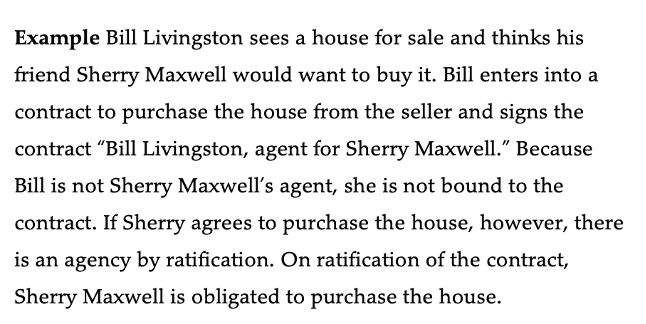
Apparent Agency
Arises when a principal creates the appearance of an agency that does not exist
Principal is estopped from denying the agency relationship and is bound to contracts entered intoby the apparent agent
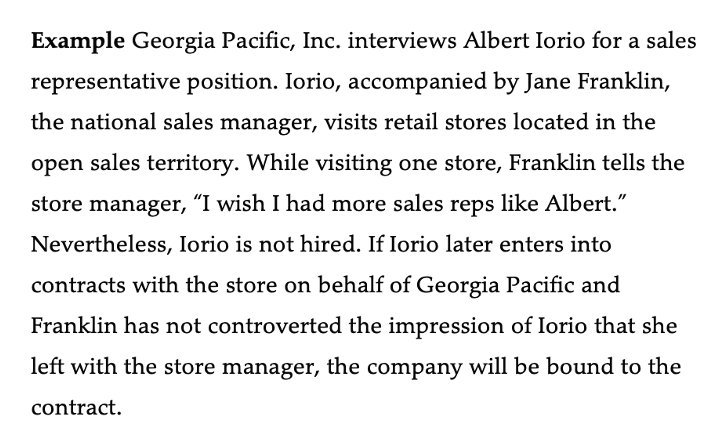
Principal’s Duties - Duty to Compensate
If no agreement, the principal must pay a customary fee paid in the industry. If no custom, a reasonable value for the agent’s services
Principal’s Duties - Duty to Reimburse
Must reimburse expenses if they were (1) authorized by the principal, (2) within the scope of agency, and (3) necessary to discharge the agent’s duties in carrying out the agency
Principal’s Duties - Duty to Indemnify
Must indemnify the agent for any losses the agent suffers because of the principal’s conduct
Principal’s Duties - Duty to Cooperate
Must cooperate with and assist the agent in the performance of the agent’s duties and the accomplishment of the agency
Agent’s Duties - Duty to Perform
Must (1) perform the lawful duties expressed in the contract, and (2) meet the standards of reasonable care, skill, and diligence implicit in all contracts
Standard of care is based on an agent in the same occupation in the same locality under the same circumstances

Agent’s Duties - Duty to Notify
Must notify the principal of important information learned concerning the agency
Information learned by the agent in the course of the agency is imputed to the principal, even if the agent does not tell the principal

Agent’s Duties - Duty to Account
Must maintain an accurate accounting of all transactions
Must (1) maintain a separate account for principal, and (2) use the principal’s property in an authorized manner
Termination of an Agency - Termination by an Act of the Parties
Mutual assent of the parties
A stated time has lapsed
If a specified purpose is achieved
The occurrence of a stated event
(examples for all 4 on class 11 slides)
Termination of an Agency - Notice of Termination
Direct notice to all persons who the agent has dealt with
Constructive notice to any party that has knowledge of the agency but has not dealt with the agent
Termination of an Agency - Termination by an Unusual Change of Circumstances
There must be a change in circumstances that would lead the agent to believe that the principal’s original instructions should no longer be valid

Termination of an Agency - Termination by Impossibility of Performance
A situation arises that makes the fulfillment of the agency impossible
Loss or destruction of the subject matter
Loss of a required qualification
A change in law
Termination of an Agency - Termination by Operation of Law
Occurs in the following circumstances:
The death of the principal or the agent
The insanity of either the principal or the agent
The bankruptcy of the principal
The outbreak of a war between the principal’s country and the agent’s country
Termination of an Agency - Wrongful Termination
If the principal’s or agent’s termination of an agency contract breaches the contract, the other party can sue for damages
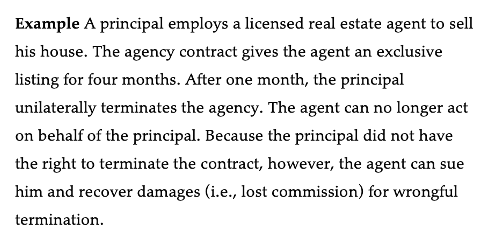
Agent’s Duty of Loyalty
Agent owes principal a duty of loyalty in all agency-related matters
Agent owes a duty not to act adversely to the interests of the principal
Agent’s Duty of Loyalty - Self-Dealing
Remedy: Principal has the ability to rescind the purchase and recover the money paid to agent

Agent’s Duty of Loyalty - Usurping an Opportunity
Occurs when an agent is offered a business opportunity or another opportunity that is meant for the principal or that the principal is entitled to be informed about and takes it for themselves
A third-party offer must be conveyed to the principal
Agent can only take the opportunity for itself if the principal rejects the opportunity
Remedy: Principal has the ability to recover the opportunity from the agent
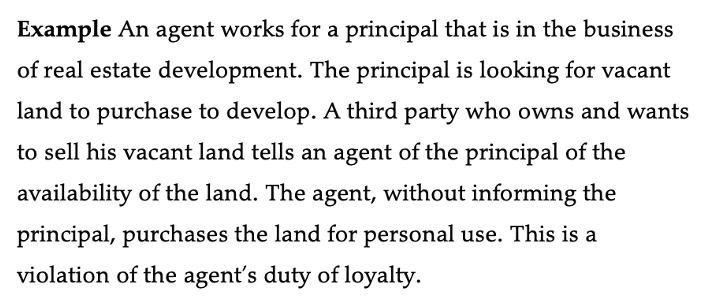
Agent’s Duty of Loyalty - Competing with the Principal
Remedy: Principal may recover the profits made by the agent as well as damages caused by the agent

Agent’s Duty of Loyalty - Dual Agency
Occurs when an agent acts for two or more different principals in the same transaction
All parties must consent to a dual agency
Remedy: Agent must forfeit all compensation received in the transaction
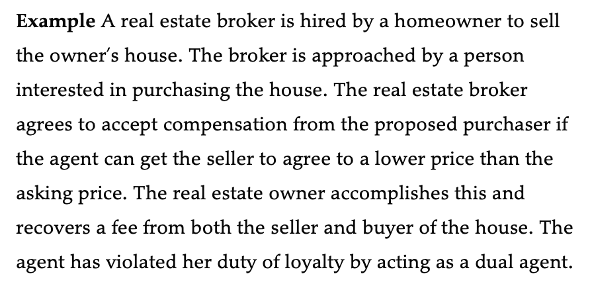
Agent’s Duty of Loyalty - Misuse of Confidential Information
Duty applies during and after the course of the agency
Duty does not prohibit using general information, knowledge, or experience acquired during an agency in later employment
Remedy: Principal can recover damages, lost profits, and any remuneration the agent received from another party to obtain the confidential information. Principal can also obtain an injunction.
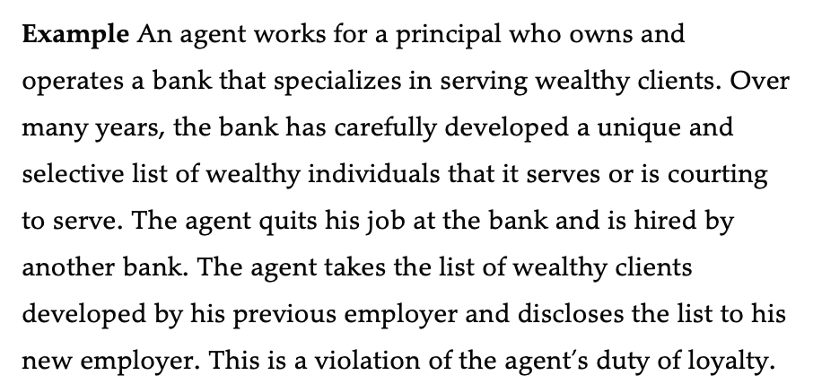
Tort Liability of Principals and Agents
Generally
Principal and agent are each personally liable for their own tortious conduct
Principals are liable for tortious conduct committed by agents while they are acting within the scope of the authority given to them by the principal
Agent is only liable for tortious conduct of the principal if they directly or indirectly participate in or aid and abet the principal’s conduct
Employment context – “scope of employment”
Tort Liability of Principals and Agents - Negligence
Principals are liable for the negligent conduct of agents acting within their scope of employment
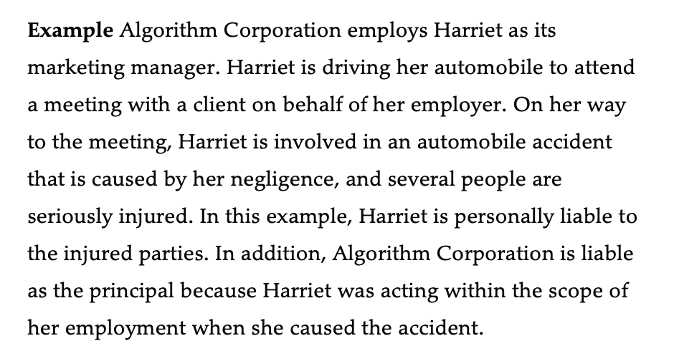
Tort Liability of Principals and Agents - Frolic and Detour
An agent my run a personal errand while on assignment for the principal
Principals are generally relieved of liability if the agent’s frolic and detour is substantial.
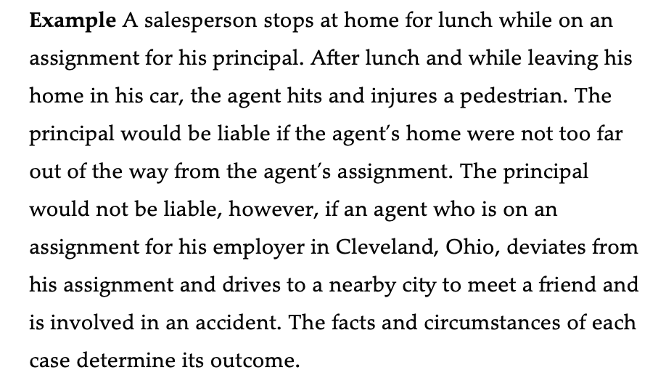
Tort Liability of Principals and Agents - Coming and Going
Principal is generally not liable for injuries caused by agents while they are on their way to and from work
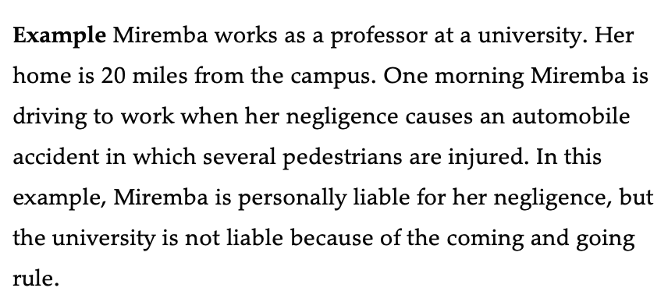
Tort Liability of Principals and Agents - Dual-Purpose Mission
Principal is generally liable for agent’s act if the principal requests that the agent run errands or conduct other acts while the agent is on personal business

Liability for Intentional Torts
Include acts such as assault, battery, false imprisonment, and other intentional conduct that causes injury to another person
Principal is not liable for the intentional torts of agents and employees that are committed outside of the principal’s scope of business
Principal may be liable for intentional torts of agents and employees committed within the agent’s scope of employment
Motivation test
- if the agent’s motivation for committing the intentional tort is to promote the principal’s business
- if the agent’s motivation is personal, the principal is not liable, even if the tort takes place during business hours or at work
Work-Related Test
- if the agent commits an intentional tort within a work-related time or space, the principal is liable
Liability for Intentional Torts - Misrepresentation
A principal is liable for the intentional and innocent misrepresentations made by an agent acting within the scope of employment
Remedy: Third party can either (1) rescind the contract with the principal and recover any consideration paid, or (2) affirm the contract and recover damages
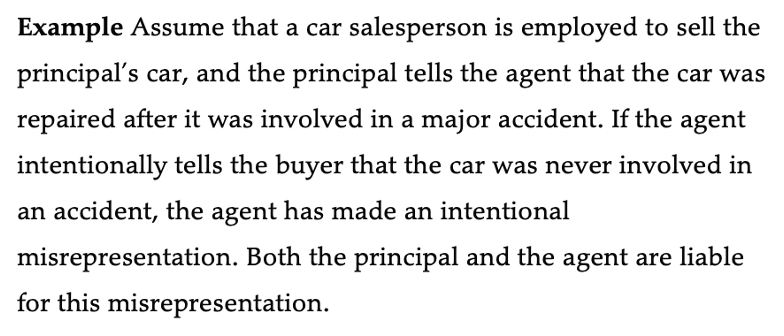
Contract Liability of Principals and Agents to Third Parties - Fully Disclosed Agency
Occurs if a third party entering into a contract knows (1) that the agent is acting as an agent for a principal, and (2) the actual identity of the principal
The principal is liable on the contract
The agent is not liable on the contract
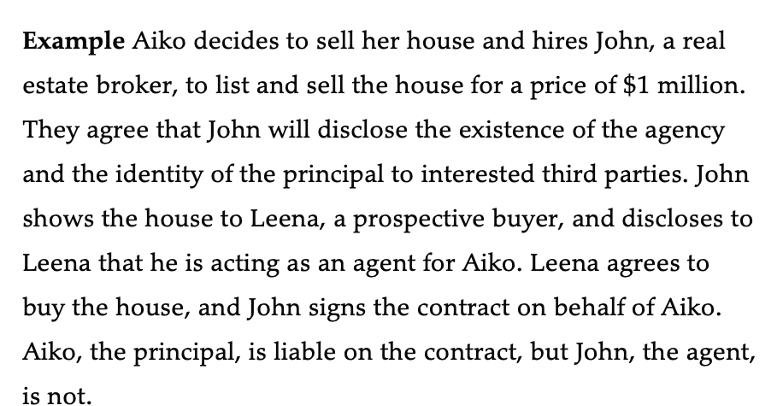
Contract Liability of Principals and Agents to Third Parties - Partially Disclosed Agency
Occurs if an agent discloses his or her agency status but does not reveal the principal’s identity (and the third party doesn’t otherwise know the principal’s identity)
Both the principal and agent are liable on the contract
If the agent is made to pay the contract, though, it can sue the principal for indemnification
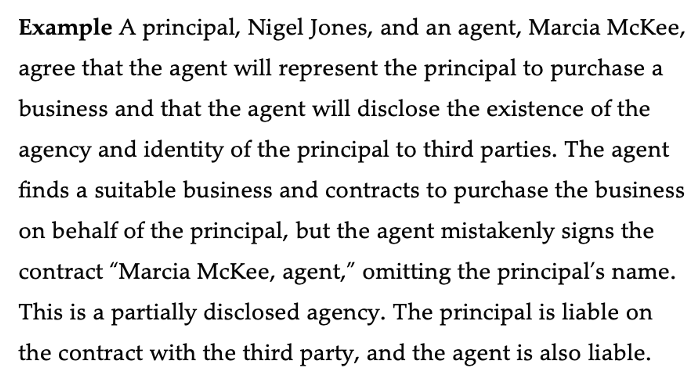
Contract Liability of Principals and Agents to Third Parties - Undisclosed Agency
Occurs when a third party is unaware of the existence of an agency
Both the principal and agent are liable on the contract
If the agent is made to pay the contract, though, it can sue the principal for indemnification
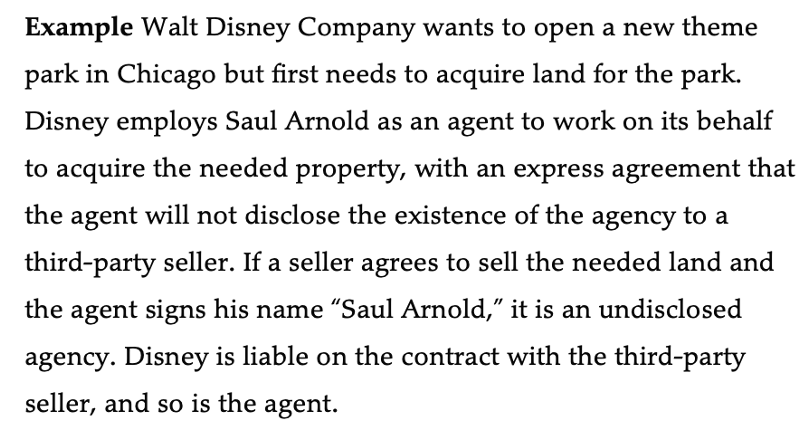
Contract Liability of Principals and Agents to Third Parties - Agent Exceeding the Scope of Authority
If the agent exceeds the scope of his or her authority, the principal is not liable on the contract
The agent is liable to the third party for breaching the implied warranty of authority
Third party must show (1) reliance on the agent’s representation, and (2) ignorance of the agent’s lack of status
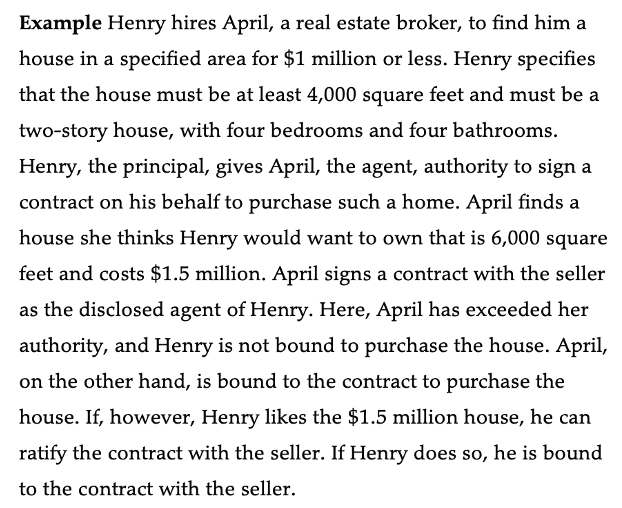
Factors for Determining Independent Contractor Status
“a person who contracts with another to do something for him who is not controlled by the other nor subject to the other’s right to control with respect to his physical conduct in the performance of the undertaking”
The crucial factor is the degree of control that the principal has over that party
Other critical factors
Whether the principal supplies the tools and equipment used in the work
The method of payment
The degree of skill necessary to complete the task
Whether the employer has the right to control the manner and means of accomplishing the desired result
Liability for an Independent Contractor’s Torts
Generally, a principal is not liable for the torts of its independent contractors
Principals cannot avoid liability for an inherently dangerous activity that they assign to an independent contractor (i.e., use of explosives, clearing land by fire, crop dusting, and other inherently dangerous activities that involve special risks)
Liability for an Independent Contractor’s Contracts
A principal can authorize an independent contractor to enter into contracts
If the principal does not authorize the independent contractor, it will not be liable under the contract
Principals are bound by the authorized contracts of their independent contractors
U.S. Constitution - Functions
(1) creates 3 branches of federal government
(2) protects individual rights by limiting the government’s ability to restrict those rights
U.S. Constitution - Federalism and Delegated Powers
Federalism – the federal government and the 50 state governments share powers
Enumerated powers (Article I, Section 8)
Necessary and Proper Clause
Any powers not specifically delegated to the federal government are reserved to the states
U.S. Constitution - Separation of Powers
(1) Legislative Branch (Article I)
(2) Executive Branch (Article II)
(3) Judicial Branch (Article III)
U.S. Constitution - Checks and Balances
built in to ensure that no one branch becomes too powerful
Commerce Clause
Grants Congress the power to regulate commerce with foreign nations, among the several states, and with Indian tribes
Intended to foster the development of a national market and free trade among the states
Commerce Clause - Foreign Commerce
A clause of the U.S. Constitution that vests Congress with the power “to regulate commerce with foreign nations.”
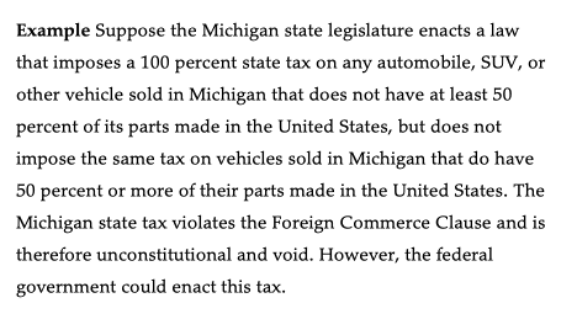
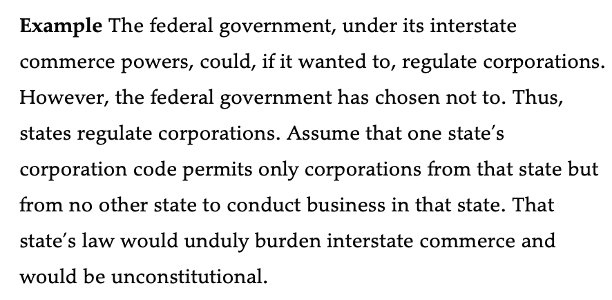
Commerce Clause - Interstate Commerce
Federal government may regulate activities that affect interstate commerce
The regulated activity does not itself have to be in interstate commerce
Wickard v. Filburn
State Police Power
States retained the power to regulate intrastate commerce and much of interstate commerce occurring within their borders
Permits states to enact laws to protect or promote the public health, safety, morals, and general welfare
Dormant Commerce Clause
A situation where the federal government has the power to regulate an area of commerce but has chosen not to
Prohibits a state from unduly burdening interstate commerce

Due Process
5th and 14th Amendments contain a Due Process Clause
No person shall be deprived of “life, liberty, or property” without due process of law
Substantive Due Process
Procedural Due Process

Equal Protection
14th Amendment
Equal Protection Clause - provides that a state cannot “deny to any person within its jurisdiction the equal protection of the laws”
Prohibits state, local, and federal governments from enacting laws that classify and treat “similarly situated” persons differently
Designed to prohibit invidious discrimination – it does not make the classification of individuals unlawful per se
Standards of Review
Strict Scrutiny – if based on a suspect class or involves fundamental rights
Intermediate Scrutiny – if based on a protected class other than a suspect class or fundamental right
Rational Basis
Equal Employment Opportunity Commission
Equal Employment Opportunity Commission (EEOC)
Federal agency responsible for enforcing most federal antidiscrimination laws
Has jurisdiction to investigate charges of discrimination based on race, color, national origin, gender, religion, age, disability and genetic information
Complaint Process
A person who thinks they have been discriminated against in the workplace must first file a complaint with the EEOC
If EEOC finds a violation, it will decide whether to sue the employer
If EEOC chooses to sue the employer, the employee cannot bring the suit.
If EEOC chooses not to bring a suit or doesn’t find a violation, it will issue a right to sue letter to employee
Lilly Ledbetter Fair Pay Act of 2009
Each discriminatory pay decision restarts the statutory 180-day clock contained in The Civil Rights Act
Provides that a court can award back pay for up to 2 years preceding the filing of the claim if similar violations occurred during the prior 2-year period
Title VII of the Civil Rights Act of 1964
Civil Rights Act of 1964
Prohibits discrimination based on race, color, national origin, sex, and religion in public accommodations (e.g., motels, hotels, restaurants, theaters) by state and municipal government public facilities, by government agencies that receive federal funds, and by employers
Scope of Coverage of Title VII
Applies to (1) employers with 15 or more employees, (2) all employment agencies, (3) labor unions with 15 or more members, (4) state and local governments and their agencies, and (5) most federal government employers
Prohibits employment discrimination
Disparate-Treatment Discrimination vs. Disparate-Impact Discrimination (Remedies for Violation: Back pay and reasonable attorneys’ fees, Equitable remedies, and Punitive damages)
Disparate- Treatment Discrimination
Occurs when an employer treats a specific individual less favorably than others because of that person’s race, color, national origin, sex, or religion
Complainants must prove: (1) they are a member of a Title VII protected class, (2) they applied for and were qualified for the employment position, (3) they were rejected despite this, and (4) the employer kept the position open and sought applications from persons with the complainant’s qualifications
Disparate- Impact Discrimination
• Disparate-Impact Discrimination
Occurs when an employer discriminates against an entire protected class
Often proven through statistical data about an employer’s employment practices
Plaintiff must demonstrate a causal link between the challenged practice and the statistical imbalance; a statistical disparity is not enough
Can occur when an employer adopts a work rule that is neutral on its face but shown to cause an adverse impact on a protected class

Race and Color Discrimination
Title VII was enacted primarily to prohibit employment discrimination based on a person’s race and color
Title VII provides equal opportunity in employment for minority job applicants and minority employees seeking promotion

National Origin Discrimination
Title VII prohibits employment discrimination based on national origin
National origin refers to the place of origin of a person’s ancestors; physical, linguistic, or cultural characteristics; or heritage
An employer may not base an employment decision on an employee’s foreign accent unless the accent seriously interferes with the employee’s job performance

Gender Discrimination
Title VII prohibits employment discrimination based on gender
Gender discrimination occurs when an employer treats a job applicant or employee unfavorably because of that person’s sex
Examples
Direct sex discrimination (ex. An employer refuses to hire a qualified job applicant or to promote a qualified employee becaouse of his or her gender)
Quid pro quo sex discrimination (ex. A manager refuses to promote a woman unless she engages in sexual activities with him)
Sex-plus discrimination (An employer does not discriminate against women in general but does discriminate against married women or women with children)
Pregnancy Discrimination - Forbids employment discrimination against a female job applicant or employee because of her pregnancy, childbirth, or a medical condition related to pregnancy or childbirth (ex. in image)

Sexual Orientation and Gender Identity Discrimination
Bostock v. Clayton County, Georgia
EEOC interprets the prohibition in Title VII against sex discrimination to include members of the LGBTQ+ community
EEOC rules prohibit employment discrimination against LGBTQ+ job applicants and employees
Harassment
Harassment that is so severe or frequent that it creates a hostile work environment violates Title VII
Affirmative Defense
Must meet the following:
(1) employer exercised reasonable care to prevent, and promptly correct, any sexual harassing behavior, AND
(2) plaintiff-employee unreasonably failed to take advantage of any preventative or corrective opportunities provided by the employer or to otherwise avoid harm
Employer has the burden of proving the affirmative defense
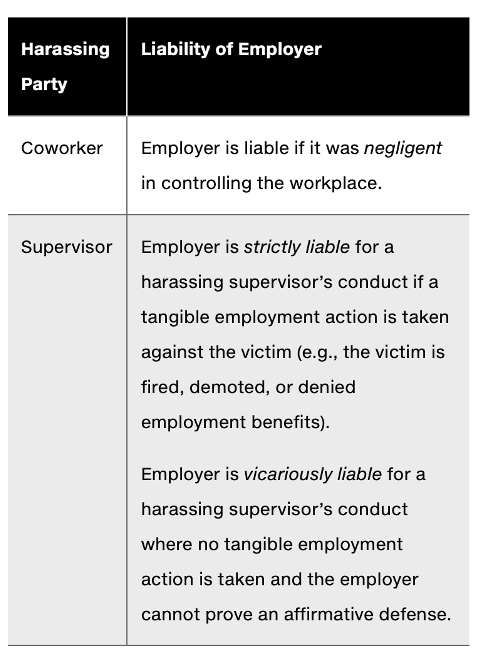
Harrassment - Classification of Harasser
Ex. A supervisor harrasses an employee because she is African American and then demotes her without cause. The employer is strictly liable for this conduct and cannot raise a defense against the imposition of strict liability.


Harrassment - Racial and National Origin Harassment
Examples in images
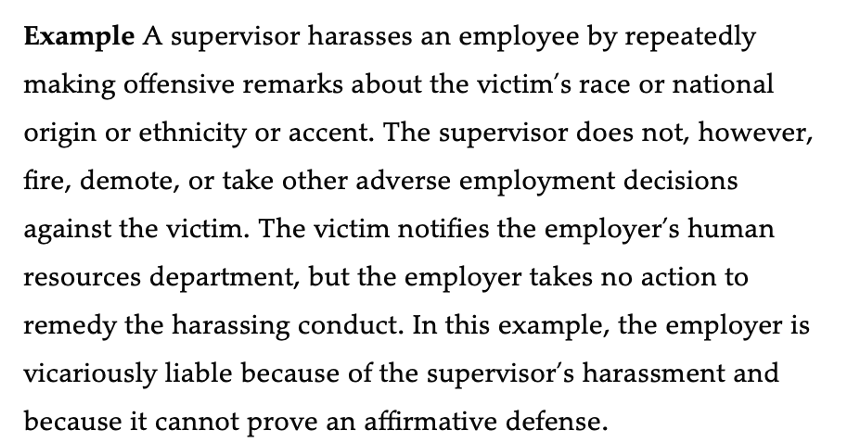
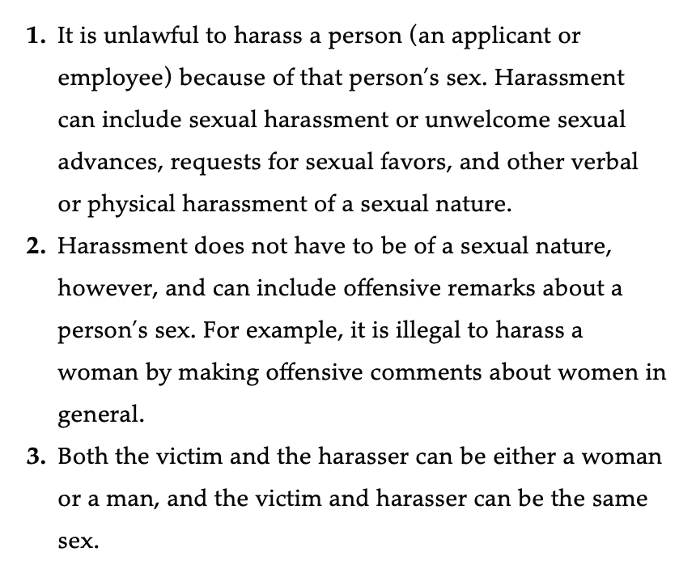
Harrassment - Sexual Harrassment
EEOC defines sexual harassment as follows: Images
In determining whether a woman has been sexually harassed, the EEOC and courts apply a reasonable woman standard (ex. If a female employee alleges that she has been sexually harrassed by a man, the court will determine the lawfulness of the conduct based on what a reasonable woman would have believed was unlawful conduct and not on what the defendant man believed was lawful conduct)
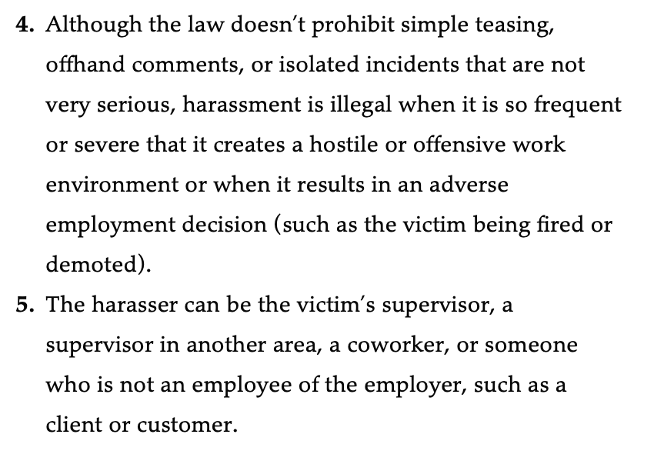
Other Types of Harassment
Age, pregnancy, disability, sexual preference, and genetic information
Religious Discrimination
Title VII prohibits employment discrimination based on a person’s religion
Employer is under a duty to make a reasonable accommodation for an employee’s religious observances, practices, or beliefs if doing so does not cause an undue hardship on the employer
“undue hardship” may occur if the requested accommodation would be costly, compromise workplace safety, decrease workplace efficiency, infringe on the rights of other employees, or require other employees to do more than their share of potentially hazardous or burdensome work
Title VII prohibits workplace or job segregation based on religion
Harassment because of religion violates Title VII if it creates a hostile work environment

Defenses to a Title VII Action
Merit
Merit decisions are often based on work, educational experience, and professionally developed ability tests. To be lawful under Title VII, such a requirement must be job related
Seniority
Bona Fide Occupational Qualification
Discrimination based on protected class OTHER than race or color is permitted if it is shown to be a bona fide occupational qualification (BFOQ)
A BFOQ must be job related and a business necessity

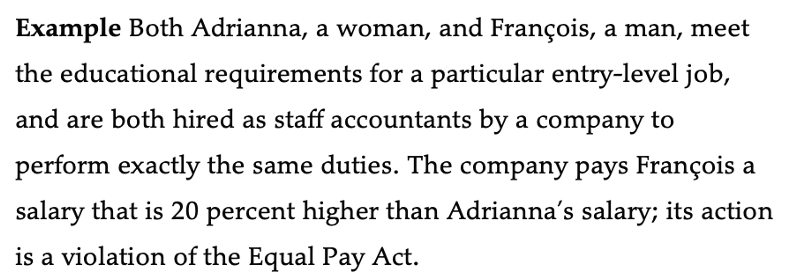
Equal Pay Act
Protects both sexes from pay discrimination based on sex
Prohibits disparity in pay for jobs that require equal skill, equal effort, equal responsibility, or similar working conditions
Criteria That Justify a Differential in Wages
Seniority
Merit
Quantity or quality of product
“Any factor other than sex”
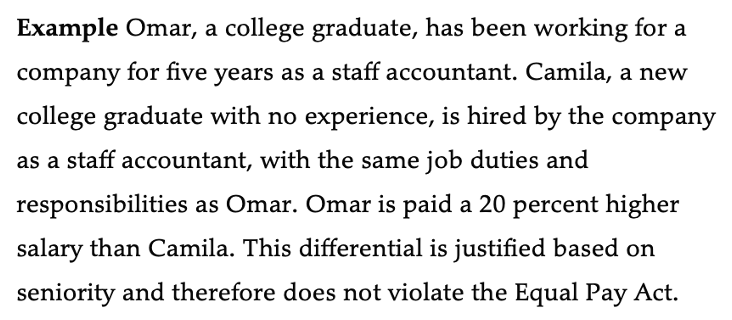
Age Discrimination in Employment Act (ADEA)
Protects employees who are 40 and older from job discrimination based on their age
Prohibits age discrimination in all employment decisions
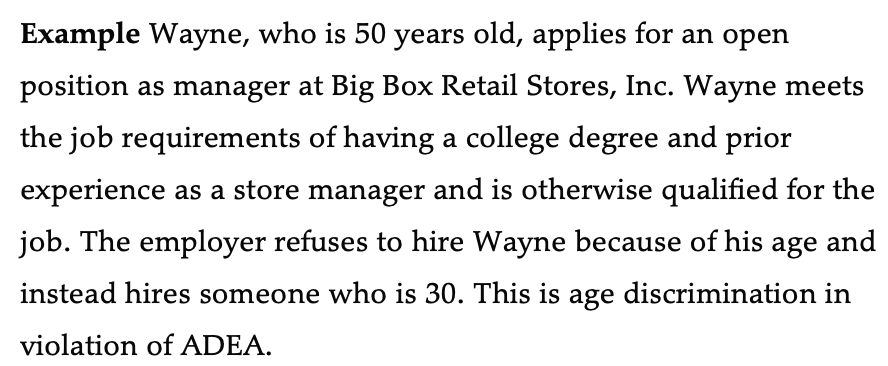
Discrimination Against Individuals with Disabilities
Americans with Disabilities Act (ADA)
Title I requires that employers make reasonable accommodations for individuals with disabilities that do not cause undue hardship to the employer
Qualified Individual with a Disability
A physical or mental impairment that substantially limits one or more major life activities, such as walking, talking, seeing, hearing, or learning
A history of such impairment
Regarded as having such impairment even if they do not have the impairment
The person with the disability must, with or without reasonable accommodation, be able to perform the essential functions of the job that person desires or holds
Limits on Employer Questions
Title I limits an employer’s ability to inquire into or test for an applicant’s disabilities
Employer may inquire about the applicant’s ability to perform job-related functions
Undue Hardship
Actions that would require significant difficulty or expense
Considerations include nature and cost of accommodation, the overall financial resources of the employer, and the employer’s type of operation
Uncovered Conditions
Temporary or nonchronic impairments of short duration with few or no residual effects usually are not considered disabilities
Genetic Information Discrimination
Discrimination based on information from which it is possible to determine a person’s propensity to be stricken by diseases
Genetic Information Nondiscrimination Act
Makes it illegal for an employer to discriminate against job applicants and employees based on genetic information
Inadvertent discovery of genetic information and voluntary submission of genetic information to an employer do not violate the act

Protection from Retaliation
Federal antidiscrimination laws prohibit employers from engaging in retaliation against an employee for filing a charge of discrimination or participating in a discrimination proceeding concerning race, color, national origin, gender, religion, age, disability, genetic information, and other forms of discrimination

Veterans and Military Personnel
Uniformed Services Employment and Reemployment Rights Act of 1994
Law protects and grants employment benefits to persons who serve or have served in the US military services or who is or has been a member of the Reserves or National Guard
Prohibits employers from engaging in employment and wage discrimination against persons because of their past military service or their current or future military obligations
Requires employers to rehire returning service members who had previously been its employee at a job that the person would have retained had he or she not been absent for military service
Requires employers to rehire persons with service-connected disabilities if the disability can be reasonably accommodated
Affirmative Action
Affirmative Action Plan
Employers often adopt an affirmative action plan that provides that certain job preferences will be given to members of minority racial and ethnic groups, women, and other protected-class applicants when making employment decisions
Narrowly tailored to achieve some compelling interest
Reverse Discrimination
Title VII also protects members of majority classes from discrimination
If an affirmative action plan is based on pre-established numbers or percentage quotas for hiring or promoting minority applications, then it causes reverse discrimination
Term Employment
Occurs when an employer and an employee enter a contract for a specified time
If an employer terminates the employee without cause during the stated period, the employer is liable for wrongful discharge
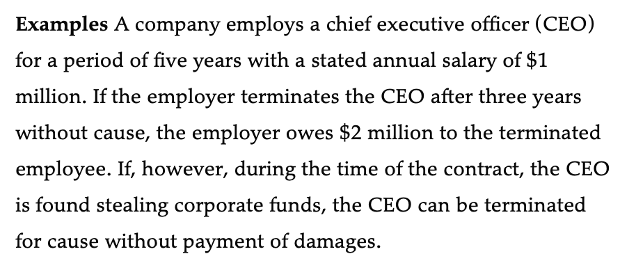
At-Will Employment
Employee can be terminated without cause at any time by employer
Employer does not need to show cause to terminate
Certain exceptions where at-will employees cannot be legally terminated
- Labor union exception
- Public policy exception
- Statutory exception

Workers’ Compensation
compensation paid to workers and their families when workers are injured in connection with their jobs
Worker must file a claim with the appropriate state government agency
The agency determines the legitimacy of the claim
Benefits are paid according to preset limits established by statute or regulation
Workers’ Compensation Insurance
States typically require employers to purchase workers’ compensation insurance or contribute to state funds
Worker’s Compensation - Employment-Related Injury
In order to receive compensation, the employee must prove they were harmed by an employment-related injury
Covers physical injuries as well as stress and mental illness
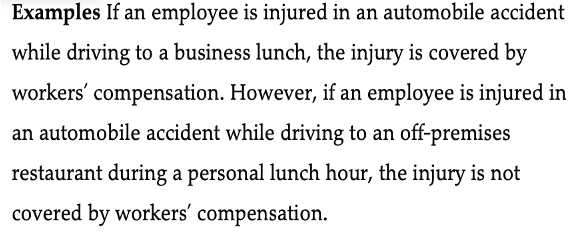
Worker’s Compensation - Exclusive Remedy
Workers cannot receive workers’ compensation and sue their employers unless the employer intentionally injures the worker
Employees not barred from suing third parties
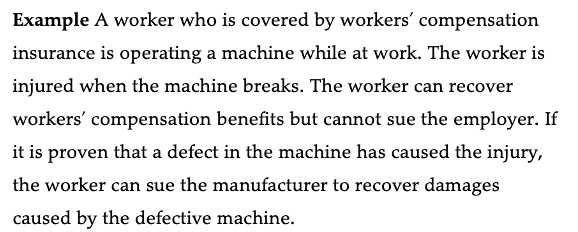
Occupational Safety and Health Act
Promotes safety in the workplace
Imposes record-keeping and reporting requirements on employers
Requires employers to post notices in the workplace to inform employees of their rights under the act
Occupational Safety and Health Administration (OSHA)
Empowered to inspect places of employment for health hazards and safety violations
Occupational Safety - Specific Duty Standards
Rules that are developed for and apply to specific equipment, procedures, types of work, individual industries, and unique work conditions

Occupational Safety - General Duty Standard
Occupational Safety and Health Act contains a general duty standard that imposes a duty to provide employees with a work environment that is free from recognized hazards that have caused or are likely to cause death or serious physical harm to its employees

Fair Labor Standards Act (FLSA)
Applies to private employers and employees engaged in the production of goods for interstate commerce
U.S Department of Labor is empowered to enforce FLSA; private civil actions are permitted
Fair Labor Standards Act - Child Labor
FLSA restricts the types of occupations and jobs that children under the age of 18 may engage in
Other regulations based on whether the job is hazardous or nonhazardous
Fair Labor Standards Act - Minimum Wage
Requires employors to pay all employees a minimum hourly wage
Employer may pay less than the minimum wage to students and apprentices and may reduce the minimum wage by an amount equal to the reasonable cost of food and lodging provided to employees
Tipped employees can be paid less if the amount paid plus tips received equals at least the minimum wage
Fair Labor Standards Act - Overtime Pay
Certain employees who work more than 40 hours per week must be paid overtime pay for each hour worked beyond 40 hours
Overtime pay must be at least 1.5X
Exempt vs. nonexempt employees
Fair Labor Standards Act - Blue-Collar Workers
Workers who perform work involving repetitive operations with their hands, physical skill, and energy are nonexempt employees
Required to be paid overtime no matter how highly paid they might be
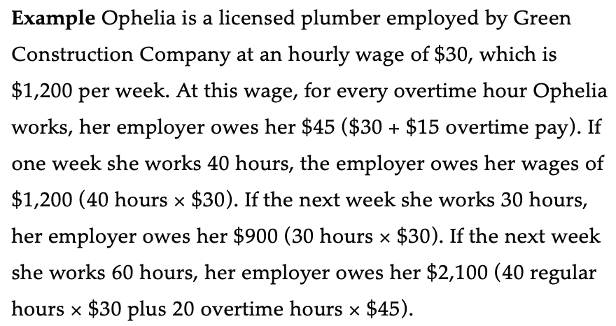
Fair Labor Standards Act - First Responders
Required to be paid overtime pay regardless of rank or pay level
Fair Labor Standards Act - White-Collar Workers
Required to be paid overtime unless exempt
SALARIED DOES NOT MEAN EXEMPT
Executive, administrative, and professional exemptions (Executive employees, Administrative employees, Learned professionals, Creative professionals, Highly compensated employees, Computer employees, Outside sales representatives, Teachers)
Fair Labor Standards Act - Job Titles and Employee Duties
Job titles do not establish exempt status
Employees who are designated by their employers to be in an exempt class must actually be performing the duties required for an exemption

Family and Medical Leave Act (FMLA)
Guarantees workers unpaid time off from work for family and medical emergencies and other specified situations
Applies to companies with 50 or more workers
Employee must have worked for the employer for at least 1 year and must have performed more than 1,250 hours of service during the previous 12-month period
Covered employers are required to provide up to 12 weeks of unpaid leave during any 12-month period due to the following
The birth of and care for a child
The placement of a child with an employee for adoption or foster care
A serious health condition that makes the employee unable to perform their duties
Care for a spouse, child, or parent with a serious health problem
Consolidated Omnibus Reconciliation Act (COBRA)
An employee of a private employer or the employee’s beneficiaries must be offered the opportunity to continue group health insurance after the voluntary or involuntary termination of a worker’s employment or the loss of coverage due to certain qualifying events
Typically available for 18 months after employment has ended
Employee Retirement Income Security Act (ERISA)
If employers establish pension plans for their employees, they are subject to certain record-keeping, disclosure, fiduciary duty, and other requirements
Requires pension plans to be in writing and to name a pension fund manager who owes a fiduciary duty to the fund
Vesting – a nonforfeitable right to receive pension benefits
Immediate vesting of employee’s own contribution
Employer’s contributions must either (1) totally vest after 5 years, or (2) gradually vest over a 7-year period
Unemployment Compensation
Employers pay unemployment contributions
State governments administer unemployment compensation programs under guidelines set by the federal government
Each state establishes its own eligibility requirements and benefits
Applicants must be able to work and available for work and seeking employment
Workers who have been let go because of bad conduct or who voluntarily quit work without just cause are not eligible
Social Security
Provides limited retirement and death benefits to certain employees and their dependents
Benefits include: (1) retirement benefits, (2) survivors’ benefits to family members of deceased workers, (3) disability benefits, and (4) medical and hospitalization benefits
Employees must make contributions into the Social Security fund. Employers pay a matching amount.
Current contributions used to fund current claims
Negotiable Instruments - Drafts
An unconditional written order by one party (drawer) that orders a second party (drawee) to pay money to a third party (payee)
For drawee to be liable, it must accept the drawer’s written order to pay
Time draft (paid at a particular time) vs. sight draft (payable on demand)
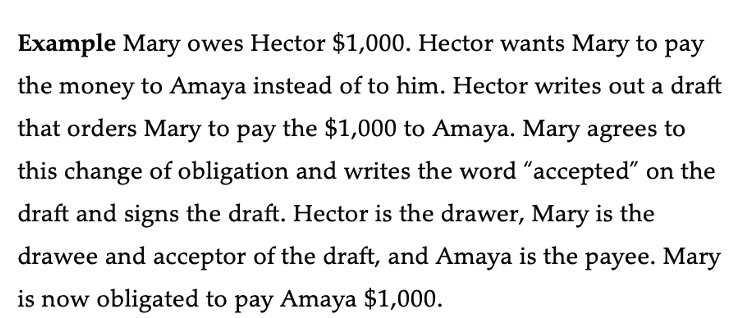
Negotiable Instruments - Check
An order to pay drawn on a financial institution

Negotiable Instruments - Promissory Note
An unconditional written promise by one party to pay money to another party
Typically arises when one party borrows money from another
The note is evidence of (1) the extension of credit, and (2) the borrower’s promise to repay the debt
Parties are free to design the terms of the note to fit their needs

Negotiable Instruments - Certificate of Deposit
A special form of note that is created when a depositor deposits money at a financial institution in exchange for the institution’s promise to pay back the amount of the deposit plus an agreed-on rate of interest on the expiration of a set time period agreed by the parties
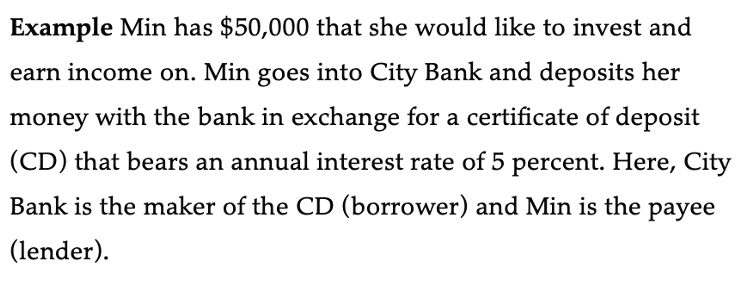
Requirements for Creating a Negotiable Instrument - Be in Writing
Must be (a) in writing and (b) permanent and portable
Can be combinations of different types of writing
